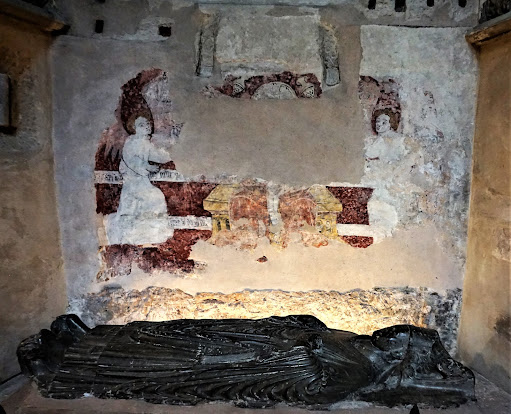Harwood[1] described an ancient painting discovered in the south aisle, on the wall of the cathedral, under whitewash, by the Revd. Theophilus Buckeridge, Master of St. John's Hospital (Master from 1769). He added without reference it was supposed to have been put up by Oliver De Langton, Rector of Wyggan in 1450. This is presumed to be the fresco James Wyatt in c.1787 limewashed over prior to placing Bishop John Hacket’s tomb in the bay of the window. The painting was re-found in 1979 when Hacket’s tomb was moved again to the western end of the aisle opposite the verger’s room (Duckit). This time the limewash was carefully removed to reveal a trinitarian fresco,[2] dated 14th or 15th-century.
 |
| Trinitarian fresco. In front is the upper slab of possibly Bishop Pateshull’s monument. |
The scene is from Revelation 8, 3. “Another angel with a golden censer came and stood at the altar; he was given a great quantity of incense to offer with the prayers of all the saints on the golden altar that is before the throne.”
God, only
his head and feet showing, sits on a yellow or golden throne; his knees clad
with a red tunic. He holds a cross on which is the crucified Christ. Only
Christ’s lower torso and legs with nails and the base of the cross are visible.
The Holy Spirit, presumably in the form of doves, is missing. Two angels each
with large wings and swinging censers flank God. Within the image are words in
Latin presumably from Revelation.
 |
| Trinitarian fresco annotated |
 |

[1] T. Harwood, The history
and antiquities of the church and city of Lichfield. London: 1806), 112.
[2] A fresco is a painting done rapidly in watercolour on wet plaster, on
a wall or ceiling. The pigments penetrate the plaster and become fixed.
[3] A. B. Clifton, A. B.The
Cathedral church of Lichfield. (London: 1900), 96..
